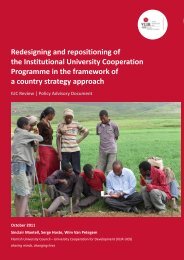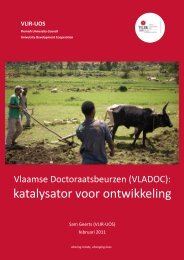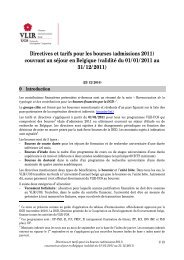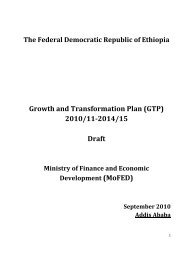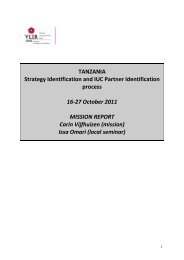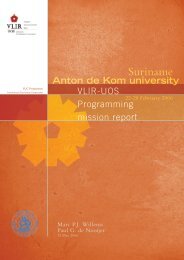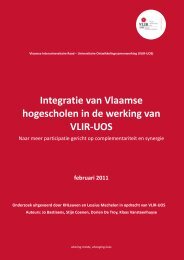Education Sector Development Program - VLIR-UOS
Education Sector Development Program - VLIR-UOS
Education Sector Development Program - VLIR-UOS
Create successful ePaper yourself
Turn your PDF publications into a flip-book with our unique Google optimized e-Paper software.
<strong>Education</strong> <strong>Sector</strong> <strong>Development</strong> <strong>Program</strong> IV<br />
❚<br />
❚<br />
Knowledge and skills of<br />
administrators and school staff<br />
enhanced through behaviour-centred<br />
and skill-based health education<br />
Create conducive policy environment<br />
related to school health and nutrition<br />
Key outcome indicators<br />
% of school children provided with one or more<br />
school health and nutrition services in school<br />
% of schools provided with access to safe<br />
drinking water<br />
Number of teachers trained on life skills based<br />
education<br />
Agreement signed and operational guideline<br />
developed between Ministry of <strong>Education</strong>,<br />
Ministry of Health and Water and Sewerage<br />
Authority<br />
3. Policy and strategies<br />
The SHN strategy proposed seeks to support and<br />
augment other activities occurring in Ethiopia<br />
that aim to improve educational quality such<br />
as the General <strong>Education</strong> Quality Improvement<br />
<strong>Program</strong> (GEQIP) and School Improvement<br />
Planning (SIPs). The strategy aims to help ensure<br />
that children are healthy and better nourished and<br />
able to take full advantage of what is often their<br />
only opportunity for formal education. By doing<br />
this, SHN promotes learning, and simultaneously<br />
reduces repetition and absenteeism, and SHN<br />
can be amongst the most cost-effective means of<br />
improving educational quality.<br />
4. <strong>Program</strong> Matrix<br />
Strategies and Component activities Indicator/target *<br />
Component 1: Use of School Health and Nutrition<br />
services by schools improved<br />
Mobilize local health service providers in<br />
assessment and provision of health and nutrition<br />
services such as mass de-worming at least<br />
once in a year, first aid, school feeding, Vitamin<br />
A capsule, referral to health services, counselling<br />
or psychosocial support etc as needed<br />
Promote adequately iodized salt by establishing a<br />
school-based iodine monitoring system with use<br />
of rapid test kits.<br />
Conduct annual screening for vision, hearing and<br />
oral health<br />
Encourage school garden in the school to promote<br />
good nutrition practices and serve as a bridge for<br />
knowledge transfer on nutrition and environment<br />
protection concept to the community<br />
Component 2: Healthy School Environment<br />
promoted<br />
Adequate and safe water supply and sanitary<br />
facilities made available at schools<br />
Component 3: Knowledge and skills through<br />
behaviour-centred and skill-based health<br />
education enhanced<br />
% of school children provided with one or more<br />
school health and nutrition services in schools<br />
% of schools with rapid test kits<br />
% of school children with minor ailments identified<br />
and treated<br />
% of schools with established school garden<br />
% of schools provided with access to safe<br />
drinking water<br />
% of schools with hand washing facilities, and<br />
waste disposal facilities<br />
% of schools with access to adequate toilet<br />
facilities segregated for boys and girls<br />
Number of teachers trained on life skills based<br />
education<br />
* See comment on indicators and/or targets at the beginning of chapter 3.<br />
86




